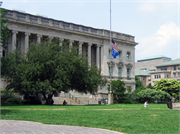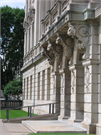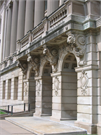Property Record
816 STATE ST
Architecture and History Inventory
| Historic Name: | State Historical Society of Wisconsin |
|---|---|
| Other Name: | Wisconsin Historical Society Headquarters (DOA #245010001) |
| Contributing: | Yes |
| Reference Number: | 16108 |
| Location (Address): | 816 STATE ST |
|---|---|
| County: | Dane |
| City: | Madison |
| Township/Village: | |
| Unincorporated Community: | |
| Town: | |
| Range: | |
| Direction: | |
| Section: | |
| Quarter Section: | |
| Quarter/Quarter Section: |
| Year Built: | 1900 |
|---|---|
| Additions: | 1914 1968 |
| Survey Date: | 19742019 |
| Historic Use: | museum/gallery |
| Architectural Style: | Neoclassical/Beaux Arts |
| Structural System: | |
| Wall Material: | Limestone |
| Architect: | FERRY AND CLAS |
| Other Buildings On Site: | |
| Demolished?: | No |
| Demolished Date: |
| National/State Register Listing Name: | Bascom Hill Historic District |
|---|---|
| National Register Listing Date: | 9/12/1974 |
| State Register Listing Date: | 1/1/1989 |
| National Register Multiple Property Name: | |
| National/State Register Listing Name: | State Historical Society of Wisconsin |
| National Register Listing Date: | 2/23/1972 |
| State Register Listing Date: | 1/1/1989 |
| National Register Multiple Property Name: |
| Additional Information: | A 'site file' exists for this property. It contains additional information such as correspondence, newspaper clippings, or historical information. It is a public record and may be viewed in person at the Wisconsin Historical Society, Division of Historic Preservation-Public History. COST OF ORIGINAL BUILDING WAS $750,000. MAP CODE = 0709-143-0401-2. Historical Library addition is DOA #245010001A. The limestone Wisconsin Historical Society Building was built in two stages between 1900 and 1914. (A rear addition dates from 1965-9.) Ferry and Clas’s design captures the essence of Beaux-Arts Classicism, with its symmetrical composition, rusticated stone foundation, balustraded roof deck, and different window treatments at each floor. The cartouches, leaf-shaped keystones, and console brackets carved as lions’ heads show the style’s penchant for embellishment. The interior is a veritable encyclopedia of classical moldings and ornaments. Mosaics on the lobby floor depict the colophons of Renaissance and colonial-era publishers. The building’s grandest interior space is its three-story Reading Room, with soaring Ionic colonnades, a balustraded balcony, and a coffered, stained-glass ceiling. Today the building houses the offices, library, and archives of the Wisconsin Historical Society. It once housed the university library (which had moved here from Assembly Hall) as well. Wisconsin Historical Society is contributing to the Bascom Hill Historic District, NR listed 1974, NRIS #: 74000065 A Historic Structure Report of this building can be found in Room 312 at the Wisconsin Historical Society. City of Madison, Wisconsin Underrepresented Communities Historic Resource Survey Report: Charles Brown was born in Milwaukee in 1872. In 1900, he became an assistant at the Milwaukee Public Museum, where he reorganized the Wisconsin Natural History Society. In 1903, he helped found the Wisconsin Archeological Society, and in 1904, he was the curator of the United States Philippine Exposition at the St. Louis World Fair. Charles E. Brown was appointed the Director of the State Historical Society of Wisconsin Museum in 1908, serving as its first full-time curator, and moved to Madison. In 1915, Brown was also named to the faculty of the University of Wisconsin-Madison. Charles E. Brown, an American of Anglo-German heritage, devoted much of his professional life to the study and preservation of Indian culture and artifacts as an archaeologist. He published numerous pamphlets and booklets on a wide range of related subjects and organized surveys of native resources across Wisconsin. Brown was instrumental in identifying, studying, and cataloging the mounds around the lakes of Mendota, Monona, Wingra, Waubesa, and Kegonsa and the associated Native American culture associated with them. He estimated that there were at least 887 earthen mounds in the region. He led an effort, from 1908 to 1946, to preserve the mounds, which are sacred to the Ho-Chunk and other native peoples. About 65 percent of the mounds in Dane County, he estimated, have been destroyed during the last two centuries. From 1935 to 1938, Brown also served as director of the Wisconsin Federal Writers Project. During his life, he was the recipient of many academic awards in his field including the Louisiana Purchase Exposition Medal in 1904, the Lapham Medal for anthropological research in 1926, an honorary master’s degree from the University of Wisconsin in 1931, and a medal from the Illinois Academy of Science for archaeological research in 1941. He held the position of director of the State Historical Society until 1945. When he took on the position, the museum had about 25,000 specimens and artifacts in its collection; when he retired the count was over 200,000 items. Charles Brown died in 1946. |
|---|---|
| Bibliographic References: | BUILDING COST WAS FOUND IN "A TABULAR HISTORY OF THE BUILDINGS OF THE UNIVERSITY OF WISCONSIN" BY ALDEN AUST 1937. Buildings of Wisconsin manuscript. Sandstone and Buffalo Robes: Madison's historic buildings, second edition, 1973. University of Wisconsin-Madison, University of Wisconsin-Madison Tour Guide, 1988. A Celebration of Architecture: Wisconsin Society of Architects Tour of Significant Architecture, 1979. |
| Wisconsin Architecture and History Inventory, State Historic Preservation Office, Wisconsin Historical Society, Madison, Wisconsin |





